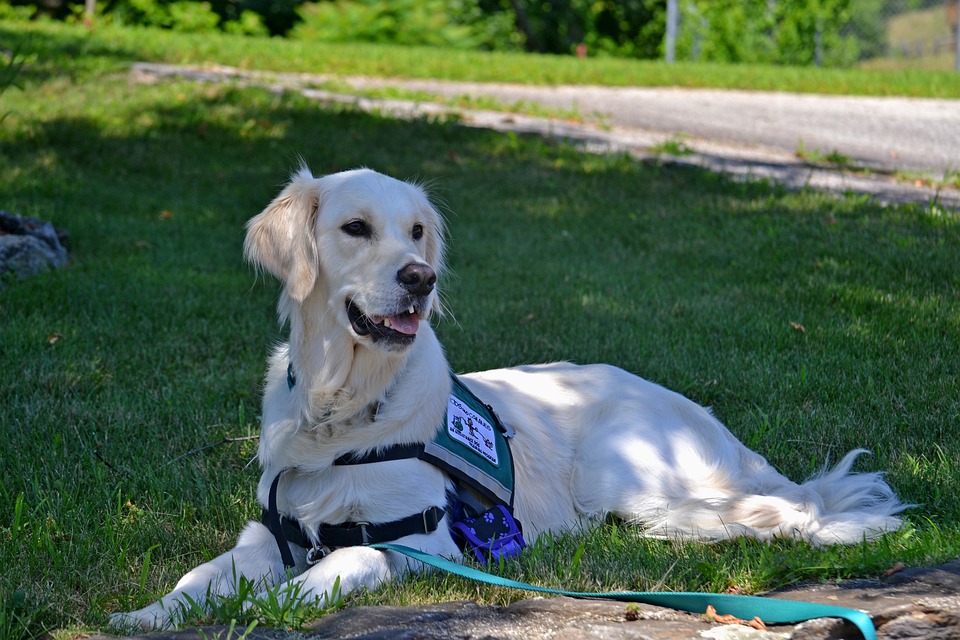September is National Service Dog Month. This month is dedicated to raising awareness and showing appreciation for the work of service dogs.
When I was 18 years old, I was diagnosed with Post Traumatic Stress Disorder (PTSD). That’s when I started working with my service dog, Mercury.
Most people think that PTSD occurs only to those who have served in the armed forces. Actually, it’s a condition that impacts people who have experienced a variety of traumatic events that include military service, sexual assault, accidents, natural disasters, and abuse. Not everyone who experiences a traumatic event will develop PTSD, but those of us who do can have flashbacks or feel like we are re-experiencing the trauma while we’re awake or asleep.
My PTSD resulted from ongoing abuse in my childhood home and was compounded by the traumatic experience of my dogs being taken from me. Although I was already involved in the dog world, until my medical team suggested a service dog might help me I hadn’t known that dogs could be trained to support someone with PTSD. Having a service dog became an instrumental part of my treatment plan.
Trusting your well-being to a dog is a unique experience, and a service dog is unlike any other treatment modality. Having a service dog completely changed my life. I went from being too afraid to leave my apartment and being unable to speak to people to graduating from college and organizing literary events.
For me, the hardest part about having PTSD is experiencing the flashbacks and panic attacks that I didn’t know were coming. They could strike at any moment — in a college lecture hall, on a bus, at the grocery store, or at the airport.
My service dog was trained to alert to minute changes in my body and help me know that a panic attack was coming. He made it possible for me to move somewhere quiet and private. Mercury was also trained to paw at me when I was disassociating in a PTSD episode and to interrupt the nightmares I experienced.

Misconceptions About Psychiatric Service Dogs
While some breeds, such as Golden Retrievers and Labrador Retrievers, commonly work as service dogs, dogs of all breeds, as well as mixed breeds, can be service dogs. Dogs can be bred purposefully to become service dogs, but they can also be rescue dogs.
Most important is the dog’s temperament and training, as well as the tasks a disabled person needs assistance with. People with disabilities who need a service dog to perform mobility tasks will be matched with a large breed dog, while people who have hearing dogs or psychiatric service dogs might choose to work with a dog of any size, including small dogs. My (now retired) service dog is a 12-pound Chihuahua mix.
Under the law, psychiatric service dogs are protected the same as guide dogs and other types of service dogs. According to the Americans With Disabilities Act, a service animal is defined as a dog that has been individually trained to do work or perform tasks for an individual with a disability. The task(s) the dog performs must be directly related to the person’s disability. Service dogs are allowed by law to accompany their handler anywhere, from restaurants and amusement parks to doctor’s offices and shopping centers.
There is no single national registration or certification that service dogs must pass. Service dogs can be trained by specialized programs or by individual handlers (often with the support or guidance of a private trainer).
Psychiatric Service Dogs
To be eligible for a psychiatric service dog, a person must be diagnosed with a mental health condition that is debilitating. Service dogs for people with psychiatric disabilities are specially trained to perform tasks that mitigate a person’s disability. Providing comfort, while important, does not qualify the dog as a service dog.
Some examples of tasks psychiatric service dogs perform include alerting a handler before a panic attack or other episode occurs, interrupting repetitive or self-harming behaviors, waking a handler from nightmares, guiding an individual to a trusted support person or out of a place of business, and retrieving medication.
Recently, there have been reports of people trying to pass their dogs off as service dogs in order to bring them to areas normally limited to dogs, such as public transportation, housing, or restaurants. This can harm individuals who have disabilities and rely on service dogs to keep us safe and support us in public spaces. Additionally, untrained dogs being passed off as service dogs pose safety risks to working service dog teams.
Psychiatric service dogs are often confused with Emotional Support Animals (ESAs). The biggest difference between ESAs and service dogs is that ESAs are not trained to perform a specific job or task, and they do not have all of the public access rights of a service dog (with the exception of air travel, in some cases, and housing).

Public Access
Under the law, all service dogs are considered the same, regardless of the handler’s disability. People with “invisible disabilities,” including psychiatric disabilities, often face some of the most access challenges when they are wrongly denied entry to businesses because of the presence of their service dog. Legally, businesses are not able to ask for documentation. They can ask two questions: Is the dog a service dog? What task has the dog been trained to perform? If the handler confirms the dog is a service dog, they must be allowed access.
For me, the biggest challenge of having a service dog involves the general public. Some people would get in our way when I was trying to get to class, or get on the bus, or buy my groceries. They wanted to know my dog’s name, what he did, and why he was with me.
I know it’s hard not get excited by cute dogs in unexpected places, but whenever people see a service dog out in public, it’s best to remember not to be distracting or interfere, because this is a dog with an important job to do.
Original post found here.

